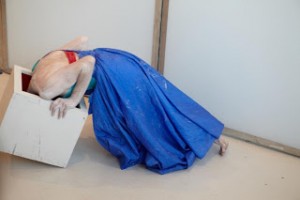Dancer's Turn Article

Coco Karol: Journey of a Female Voice in Dance
by Melanie Greene
4 o'clock in the afternoon. The air is thick and hot. Eying a table and bench made of wood, we find a cozy spot underneath a covered patio. Condensation forms on the outside of my plastic cup and runs down the back of my handarefreshingly cold against the vibrating heat. Ice cubes clash inside the container, melting into the green tea liquid. I am look forward to taking a sip of this cool refreshment.
Karol sits comfortably on an adjacent wooden bench to my right. She carefully sips her tea, while I sip mine. In the shade, we catch bouts of wind that we gladly coax through the fibers of our clothes and against our skin. Taking one last sip of our liquid refreshment, we begin to talk at length....
If you Google or Bing modern dance images, you will encounter a visual menagerie of female and male bodies frozen in suspensions, extensions, and vertical contradictions to gravity. Refine your search further to choreographers and you may peruse lists counting up and down the decades of modern and contemporary dance greats.
Iave become increasingly fascinated by discussions in recent literature surrounding the presence of the male gender bias in dance. From choreographers and company directors to performers, male visibility is undeniably large in a field dominated in numbers by women.
TheDance Advantageblog offers a possible reason for this phenomenon through a guest article written by Dorothy Gunther Pugh. Because there are fewer men, a perceived male scarcity leads to preferential treatment in the form of free training, bonuses, and unique performance opportunities and experiences (http://www.danceadvantage.net/2011/02/22/women-in-dance/a). It is within this climate that I wish to remember the female artistic voice in dance; the choreographers, creators, educators, performers, and provocateurs. To highlight the female artistic voice in dance brings into question what it means to be female or have a feminist voice in dance. The feminine mystique does not only appear in issues and content relating to females; therefore, it is not exclusive to females. This aesthetic can extend beyond culturally constructed ideas of gender, so it may be important to first define what I mean when referring to the female artistic voice.
Locating the feminist voice in dance involves considering how women and other under-represented minorities are represented in dance. It considers the stereotypes and portrayals of women and does not assume to locate a universal idea of feminine identity. It considers the fine line between oppression and empowerment. It is this voice that I wish to hear and highlight in this article.
To find the feminist voice in dance--and indeed that of other under-represented minorities--we must consider how the population is currently represented and treated in dance. We cannot assume that dance holds one universal truth about feminine identity that dictates how women should exist and participate in dance. Instead, we consider the information that flows through and around us as a tool to perceive, understand, and sometimes provoke existing circumstances. It is this information that shapes our understanding and consideration about interactions and relationships. It allows us to consider the fine line between oppression and empowerment, real and fantasy, and realized and fetishized. It is this voice that I wish to hear and highlight in this article.
I met Coco Karol during a six-week dance summer intensive in Durham, North Carolina. We participated in a theory class designed for dance professionals and artists wishing to obtain their Master of Fine Arts. We shared a unique space with others that nurtured questions and considerations about dance as it related to pedagogy, sexuality, phenomenology, and visual aesthetics.
Upon our first encounter, I was struck by Karol's careful consideration of thought during group discussions. She appeared genuine in the way she chose to articulate her ideas without appearing disrespectful, combative, or condescending.
CollectiveCollaboration Passionprojects Longhours
Distant work that brings people together
Different-Language-New Communication
Problem-solve
Collaborations cultivate a collection of ideas, insights, talents, and passion. It marries disciplines and encourages many languages to come together as one.Karol and I shared stories about the nature of collaboration and the possibilities that can manifest even when artists speak very different artistic languages. It is very rewarding when artists are able to bridge gaps and discover new ways of communicating.
Karol has worked on a series of collaborative projects with artist BjArk; photographer Steven Sebring; sculptor Eve Bailey; composer Inhyun Kim; and dancer Chloe Douglas. With each work and collaboration, Karol identifies a set of conceptual challenges that are influenced by the collaborative medium. These seeds of consideration and contemplation root the foundation of her works. As a set of challenges becomes realized, Karol sees it as an opportunity to explore new challenges. For example, when moving within the physical structures designed by Sebring, Karol spoke about how conceptual challenges served to mirror physical ones. Working inside a 360-degree photo rig with Sebring, Karol described how, athe two of us talked our way to a final product, each person at different times responding, reacting or having agency, within our respective mediums.a
As a mover, it is important to work within evolving environments that present new questions and challenges for the performer. It keeps the mind and body active, thinking, and agile. Many would agree that this trait is also advantageous in life. We have to be able to fluctuate and adjust to daily challenges. Collaboration gives you an opportunity to work with different people, which has the potential to generate unique excitement when you see awhat can happen when everyone involved is learning and growinga together.

